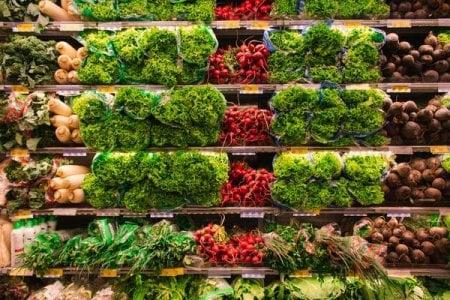Slash Your Grocery Bills: Unveil the Secret to Healthy Eating on a Budget!
By
Danielle F.
- Replies 2
As we navigate the ever-rising cost of living, finding ways to maintain a healthy diet without breaking the bank becomes increasingly important. For our savvy seniors who are looking to stretch their dollars further, we've got some good news: eating healthily doesn't have to come with a hefty price tag. Let's dive into the world of affordable, nutritious supermarket finds that will keep both your wallet and your body happy.
Frozen and canned vegetables have long been the unsung heroes of the budget-conscious shopper. While the allure of fresh produce is undeniable, there's a treasure trove of benefits to be found in the freezer and canned goods aisles. For starters, you can often find plain frozen peas, carrots, corn, and spinach for a mere $1-2 per bag or pack. These frozen gems are not only easy on the purse strings but also packed with nutrients.
It's a common misconception that frozen vegetables are less nutritious than their fresh counterparts. In reality, these vegetables are typically picked at their peak ripeness and flash-frozen, which helps to lock in vitamins and minerals. This means that you can enjoy the health benefits of vegetables all year round, regardless of the season.
Moreover, frozen vegetables are incredibly versatile. They can be used to bulk up dishes, providing extra volume and fiber without adding many calories. They're also perfect for blending into smoothies for a nutrient-packed drink or adding to soups and stews for an extra dose of goodness.
Canned vegetables are another budget-friendly option that shouldn't be overlooked. While they may not always be Australian-grown, they still offer a wealth of nutritional benefits. Canned beetroot, tomatoes, and corn are among the most affordable options, sometimes retailing for as little as $1 per can. These pantry staples are convenient and have a long shelf life, making them a practical choice for those looking to minimize food waste.
When shopping for canned vegetables, it's wise to look for options with no added salt or sugar to keep your meals as healthy as possible. And don't forget about the liquid in the can! For example, the juice from canned tomatoes can add a rich flavor to sauces and soups, while the liquid from canned beetroot can be used as a natural food coloring or in vinaigrettes.
It's also worth noting that both frozen and canned vegetables can be a boon for those with mobility issues or limited access to frequent grocery shopping trips. Having these items on hand means you can still whip up a nutritious meal without the need for frequent visits to the supermarket.
So, dear members, next time you're at the supermarket, don't just walk past the frozen and canned aisles. Embrace these affordable, nutritious options and get creative in the kitchen. Your health and your budget will thank you.

We'd love to hear from you! What are your go-to budget-friendly healthy foods? Do you have any tips for making the most out of frozen or canned vegetables? Share your thoughts and experiences in the comments below, and let's help each other live well for less.
Frozen and canned vegetables have long been the unsung heroes of the budget-conscious shopper. While the allure of fresh produce is undeniable, there's a treasure trove of benefits to be found in the freezer and canned goods aisles. For starters, you can often find plain frozen peas, carrots, corn, and spinach for a mere $1-2 per bag or pack. These frozen gems are not only easy on the purse strings but also packed with nutrients.
It's a common misconception that frozen vegetables are less nutritious than their fresh counterparts. In reality, these vegetables are typically picked at their peak ripeness and flash-frozen, which helps to lock in vitamins and minerals. This means that you can enjoy the health benefits of vegetables all year round, regardless of the season.
Moreover, frozen vegetables are incredibly versatile. They can be used to bulk up dishes, providing extra volume and fiber without adding many calories. They're also perfect for blending into smoothies for a nutrient-packed drink or adding to soups and stews for an extra dose of goodness.
Canned vegetables are another budget-friendly option that shouldn't be overlooked. While they may not always be Australian-grown, they still offer a wealth of nutritional benefits. Canned beetroot, tomatoes, and corn are among the most affordable options, sometimes retailing for as little as $1 per can. These pantry staples are convenient and have a long shelf life, making them a practical choice for those looking to minimize food waste.
When shopping for canned vegetables, it's wise to look for options with no added salt or sugar to keep your meals as healthy as possible. And don't forget about the liquid in the can! For example, the juice from canned tomatoes can add a rich flavor to sauces and soups, while the liquid from canned beetroot can be used as a natural food coloring or in vinaigrettes.
It's also worth noting that both frozen and canned vegetables can be a boon for those with mobility issues or limited access to frequent grocery shopping trips. Having these items on hand means you can still whip up a nutritious meal without the need for frequent visits to the supermarket.
So, dear members, next time you're at the supermarket, don't just walk past the frozen and canned aisles. Embrace these affordable, nutritious options and get creative in the kitchen. Your health and your budget will thank you.
Key Takeaways
- Frozen and canned vegetables are an affordable and healthy addition to the diet, available for as little as $1-2 per bag or pack.
- These budget-friendly options may include imported vegetables, yet they retain their nutritious value.
- Frozen vegetables like peas and spinach and canned varieties such as beetroot, tomatoes, and corn are some of the cheapest items one can buy at the supermarket.
- Using these frozen or canned vegetables helps increase the fibre and vegetable content in meals and can be used in a variety of ways, including in dishes, smoothies, and as side servings.








